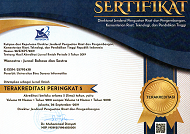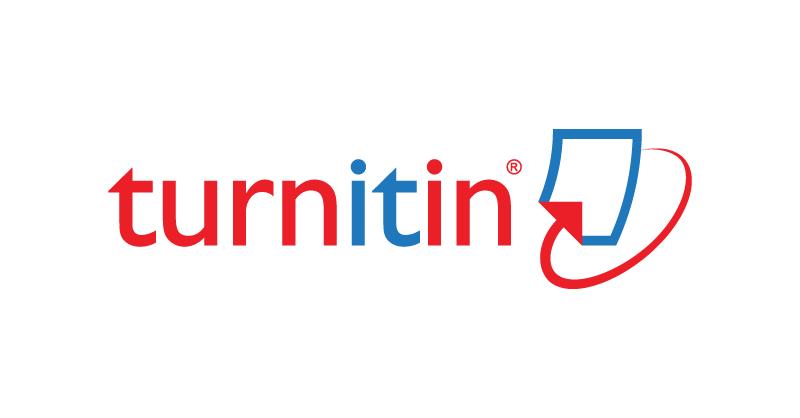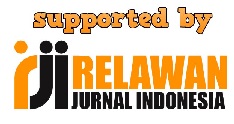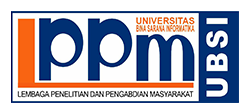Meredam Stigma dengan Komunikasi dan Sastra (Komunikasi Stigma dalam Cerpen Jenggo Karya Putu Wijaya)
Abstract
Abstract - The purpose of this study is to explore how to explore communication and literary perspectives on the study of Jenggo short story by Putu Wijaya's stigma communication. The focus of the stigma communication studied is how the community's stigma about a transvestite is considered weak. Pansy stigma arises in communication that focuses on messages. This research method is content analysis with a qualitative approach with a critical constructivist paradigm. This study analyzes stigma communication with the theory put forward by Smith (2007) with the perspective of sociology and communication by Durkheim (1947) and Goffman (1963). The results of this study lead to stigma communication that occurs in Jenggo short story including signs, labeling groups, responsibilities, hazards, to the impact of messages and the process of sharing messages. This research also proves the meaning of messages in stigma communication. In an effort to ward off stigma, literature has a big role because it is able to provide other perspectives that encourage stigma communication that is more transparent and responsible for the harmony and lasting climate of peace in society. Building positive communication within the community is expected to have an impact on the construction of stigma communication that leads to a healthy and plural society.
Keywords: Stigma, Communication, Stigma Communication, Jenggo, Putu Wijaya
Abstrak - Tujuan penelitian ini adalah untuk mengeksplorasi bagaimana menangkal stigma dengan perspektif komunikasi dan sastra pada kajian komunikasi stigma cerpen Jenggo karya Putu Wijaya. Fokus stigma yang dikaji adalah bagaimana stigma masyarakat tentang orang banci yang dinilai lemah. Stigma banci muncul dalam komunikasi yang berfokus pada pesan. Metode penelitian ini adalah analisis isi dengan pendekatan kualitatif dengan paradigma konstruktivis kritis. Penelitian ini menganalisis komunikasi stigma dengan teori yang dikemukakan Smith (2007) dengan perspektif sosiologi dan komunikasi Durkheim (1947) dan Goffman (1963). Hasil penelitian ini mengarah kalau komunikasi stigma yang terjadi pada cerpen Jenggo meliputi tanda, pelabelan kelompok, tanggung jawab, bahaya, hingga dampak pesan dan proses berbagi pesan. Penelitian ini juga membuktikan tentang arti pesan dalam komunikasi stigma. Dalam upaya menangkal stigma, sastra memiliki peran besar karena mampu memberikan perspektif lain yang mendorong komunikasi stigma lebih transparan dan bertanggung jawab demi keharmonisan dan kelanggengan iklim perdamaian di masyarakat. Membangun komunikasi yang positif di dalam komunitas diharapkan bisa memberikan dampak konstruksi komunikasi stigma yang mengarahkan ke masyarakat yang sehat dan plural.
Kata kunci: Stigma, Komunikasi, Komunikasi Stigma, Jenggo, Putu Wijaya
Full Text:
PDF (Bahasa Indonesia)References
Brashers, D. (2008). Marginality, Stigma, and Communication. The International Encyclopedia of Communication. doi:10.1002/9781405186407.wbiecm006
Caputo, N. M., & Rouner, D. (2011). Narrative processing of entertainment media and mental illness stigma. Health communication, 26(7), 595-604.
Chung, A. H., & Slater, M. D. (2013). Reducing stigma and out-group distinctions through perspective-taking in narratives. Journal of Communication, 63(5), 894-911.
Durkheim, Emile. (1947). The Division of Labor in Society (Terjemahan George Simpson). New York: The Free Press.
Flood-Grady, E., & Koenig Kellas, J. (2019). Sense-making, socialization, and stigma: Exploring narratives told in families about mental illness. Health communication, 34(6), 607-617.
Goffman, Erving. (1963). Stigma: Notes on the Management of Spoiled Identity. New Jersey: Prentice Hall.
Kaviti, L. (2015). From Stigma to Status-Sheng and Engsh in Kenya's Linguistic and Literary Space. Matatu, (46), 223.
Krippendorff, K. (2018). Content analysis: An introduction to its methodology. London: Sage publications.
McGinty, E., Pescosolido, B., Kennedy-Hendricks, A., & Barry, C. L. (2018). Communication strategies to counter stigma and improve mental illness and substance use disorder policy. Psychiatric Services, 69(2), 136-146.
Mezirow, J. (1978). Perspective Transformation. Adult Education, 28(2), 100–110. https://doi.org/10.1177/074171367802800202
Mustaqim, Andika Hendra (2013). Gotong Royong Dalam Dwilogi Padang Bulan Dan Cinta Di Dalam Gelas Karya Andrea Hirata (Sebuah Kajian Sosiologi Sastra). Jurnal Bahasa dan Sastra WANASTRA. 4. 1-9
Mustaqim, A. H. (2018). Komunikasi Sastra pada Puisi Selamat Tahun Baru Kawan Karya Mustofa Bisri. Silampari Bisa: Jurnal Penelitian Pendidikan Bahasa Indonesia, Daerah, dan Asing, 1(2), 245-263.
Osborne, L. (1974). Beyond stigma theory: A literary approach. Issues Criminology, 9, 71.
Smith, R. A. (2009). Stigma Commmunication. Dalam Encyclopedia of Communication Theory. London: Sage Publications.
Smith, R. A. (2012). An Experimental Test of Stigma Communication Content with a Hypothetical Infectious Disease Alert. Communication Monographs, 79(4), 522–538. doi:10.1080/03637751.2012.723811
Smith, R. A. (2014). Testing the Model of Stigma Communication with a Factorial Experiment in an Interpersonal Context. Communication Studies, 65(2), 154–173. doi:10.1080/10510974.2013.851095
Sudaryanto. (2011). Sastra Memulihkan Stigma Bangsa. http://cetak.kompas.com/read/2011/08/03/04094353/sastra.memulihkan.stigma.bangsa
Verdenius, W. J. (1983). The principles of Greek literary criticism. Mnemosyne, 36 (Fasc. 1/2), 14-59
Uspensky, Boris. (1973). A Poetics of Composition: The Structure of the Artistic Text and Typology of Compositional Form, trans. Valentina Zavarin and Susan Wittig (Berkeley, CA: University of California Press).
Thomas, M. (2003). Teaching fantasy: overcoming the stigma of fluff. English Journal, 92(5), Smith, R. A. (2007). Language of the Lost: An Explication of Stigma Communication. Communication Theory, 17(4), 462–485. doi:10.1111/j.1468-2885.2007.00307.x
Yusuf, M. Y. (2015). Sastra dan Difabel: Menilik Citra Difabel dalam Novel Biola Tak Berdawai dari Sudut Pandang Sosiologi Sastra Ian Watt. INKLUSI, 2(1), 21-40.
Wijaya, Putu. (2015). Jenggo. Harian Kompas. Terbit pada Minggu 25 Oktober 2015.
DOI: https://doi.org/10.31294/w.v12i1.7568
Copyright (c) 2020 Andika Hendra Mustaqim

This work is licensed under a Creative Commons Attribution-ShareAlike 4.0 International License.
Index by:
Published by Department of Research and Community Service (LPPM) Universitas Bina Sarana Informatika by supported Relawan Jurnal Indonesia
Jl. Kramat Raya No.98, Kwitang, Kec. Senen, Jakarta Pusat, DKI Jakarta 10450

This work is licensed under a Creative Commons Attribution-ShareAlike 4.0 International License







